The Huawei MateBook 16 Review, Powered by AMD Ryzen 7 5800H: Ecosystem Plus
by Dr. Ian Cutress on October 20, 2021 8:00 AM EST- Posted in
- Laptops
- AMD
- Huawei
- Matebook
- Ryzen
- Zen 3
- MateBook 16
- Huawei Share
- Ryzen 7 5800H
Power and Storage Performance
The processors used in the MateBook 16 are the latest Zen 3 based AMD Ryzen Mobile parts that exist as part of AMD’s H-Series range. The H-series, both on the side of AMD and Intel, typically run with a 45 W thermal design power (TDP) by definition, although depending on the mobile device being used, the manufacturers can adjust that TDP either up or down, given the desired cooling, performance, and battery life.
| AMD Ryzen 5000 Mobile: H-Series | |||||
| AnandTech | Cores Threads |
Base Freq |
Boost Freq |
TDP Default |
Vega |
| Ryzen 9 5980HX | 8C / 16T | 3300 | 4800 | 45W+ | Vega 8 |
| Ryzen 9 5980HS | 8C / 16T | 3000 | 4800 | 35W | Vega 8 |
| Ryzen 9 5900HX | 8C / 16T | 3300 | 4600 | 45W+ | Vega 8 |
| Ryzen 9 5900HS | 8C / 16T | 3000 | 4600 | 35W | Vega 8 |
| Ryzen 7 5800H | 8C / 16T | 3200 | 4400 | 45W | Vega 8 |
| Ryzen 7 5800HS | 8C / 16T | 2800 | 4400 | 35W | Vega 8 |
| Ryzen 5 5600H | 6C / 12T | 3300 | 4200 | 45W | Vega 7 |
| Ryzen 5 5600HS | 6C / 12T | 3000 | 4200 | 35W | Vega 7 |
Typically the TDP setting of a mobile processor isn’t just a ‘suggestion’ as with some of the desktop hardware: the power limit imposed by the TDP comes up very quickly after a few seconds of heavy loading, or even straight away for the slimmest of designs that are not designed for high thermal hotspots. As a result, we’re in a situation where looking at the processor name on a laptop or notebook means next to nothing for performance, and instead we need to look at the power use in a variety of scenarios. One day I hope that laptop vendors will list the configured power window for the processors they have tuned, but I don’t see it coming any time soon.
In this case, Huawei is using the Ryzen 7 5800H in our MateBook 16 unit: an 8-core, 16-thread processor with Vega 8 graphics. It has a nominal thermal design power of 45 W, but Huawei has configured it to run at 35 W. When run in this mode, the turbo frequencies are usually the same as the higher power mode, but when the system clamps on the maximum power, the all-core frequency is reduced to get to that level. The added bonus of this, aside from maintaining comfortable thermals on the device, is also that the processor runs nearer its peak efficiency point.
Huawei further spices it up by offering a PERFORMANCE mode. If the laptop is plugged into the wall with its 135 W charger, performance mode can be activated which allows individual cores access to the full 35 W. In all-core use, we see that the turbo time is increased, keeping the whole processor at 35 W for longer. The goal here is extra long-term performance, which we see in our testing in benchmarks that are long and compute-heavy, although we fail to see much benefit in gaming or day-to-day tasks.
To showcase this, we start with a traditionally heavy workload in Prime 95.
In this test, the Performance mode spikes at 52 W when the test begins, but then very quickly comes down to 35 W, which it continues all the way to the end of the test. By contrast, in the default balanced mode, we get 35 W for about 3 minutes, and then the processor scales back to 30 W.
Interestingly enough, we don’t see the same issue in Handbrake:
In this case both processors perform equally for the duration of the test, staying at 35 W, except for that initial 57 W spike when in performance mode. The test in this case took an identical amount of time to complete.
Agisoft is one of my tests that is more varied in the threaded workload, with a mix of all-core and single core tasks, and we see a can see a considerable different in the performance between the two modes.
I’ve adjusted the x-axis to % of benchmark complete, because the Performance mode completes the test about 6% quicker.
Here we see that the Performance mode stays at 35 W for most of the test, until the last 15% which is more single-threaded. The Balanced mode gets knocked back almost immediately to 30 W, before reducing further to 20 W. The whole test takes around 20 minutes, and the Balanced came down to 20 W around the 14-minute mark. But overall, the performance mode was quicker, at the expense of extra power.
Storage Performance
The MateBook 16, regardless of which model you buy, will come with 16 GB of DDR4-3200 and a 512 GB NVMe SSD inside. The storage in our laptop is a Samsung PM981a, which is the same PCIe 3.0 x4 drive that Huawei has been putting inside its laptops for at least two generations, if not three. It’s still a good performer, and compared to the 1 TB version we saw in the MateBook X Pro in our previous review, it is a tiny bit faster.
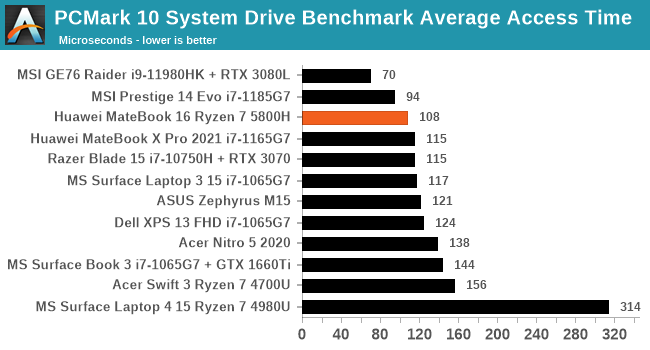
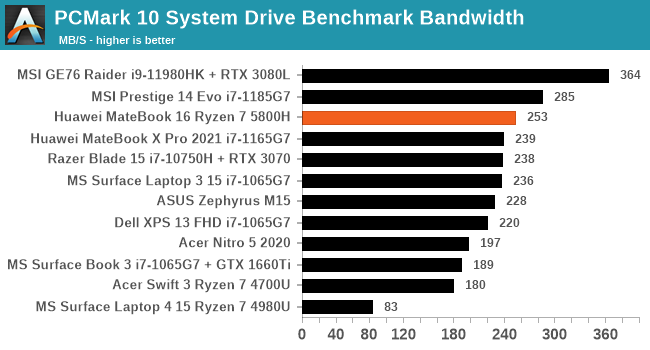
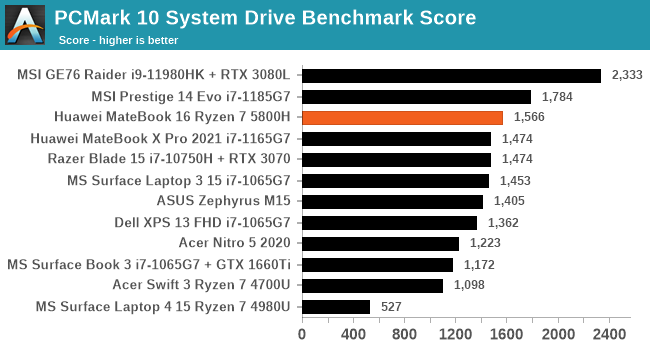
While Huawei continues to use the lowest SKU of the respective stack, such as the lowest Core i7 in the Core i7-1165G7 for the MateBook X Pro and the lowest Ryzen 7 for the Ryzen 7 5800H in the MateBook 16, there isn’t much reason for them to use anything other than the PM981a, as it remains a good drive.


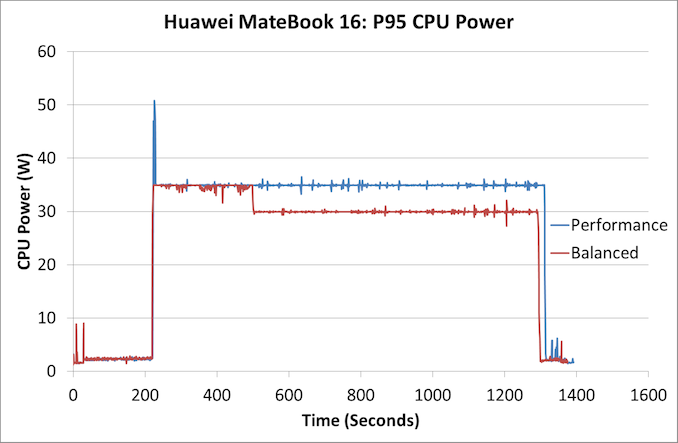
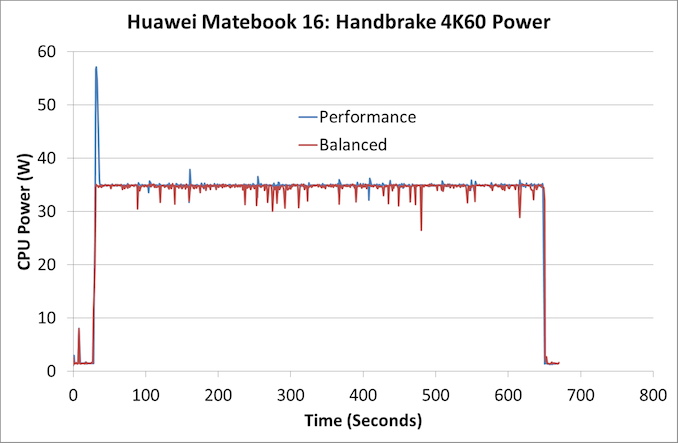
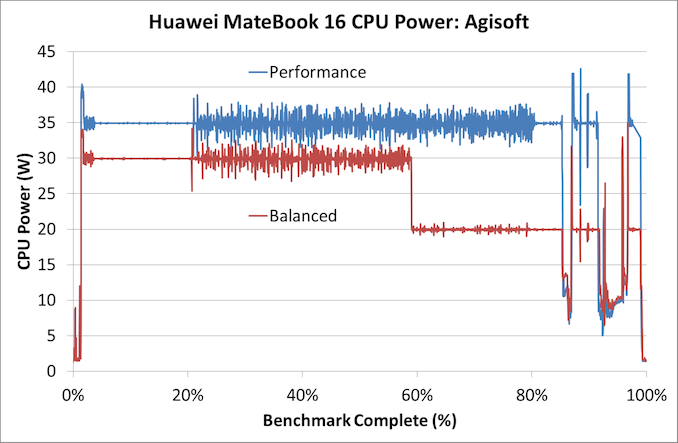








87 Comments
View All Comments
fishingbait15 - Friday, October 22, 2021 - link
Why shouldn't Huawei shamelessly copy Apple when Apple has been shamelessly copying Samsung for going on 10 years? Apple Watch? Samsung did it first. AirPods? Again, Samsung first. Apple invented the modern tablet, true, but the iPad Pro concept (oversized tablet with stylus and emphasis on detachable keyboard and multitasking in the OS) was done by the Samsung Galaxy Pro first. And again, Apple invented the iPhone, but every iPhone since 2011 has been a ripoff of the Samsung Galaxy line. Apple even copied the curved screen. Except that where Samsung actually had apps to take advantage of the curve, Apple merely copied the form without the function. And while Apple didn't copy Samsung with the Apple TV, Amazon and Google had their truly smart TV boxes first.Amazing how you guys never acknowledge Apple's blatant copying. Especially since even the Apple blogs acknowledge that Apple's latest Macs reject Jony Ive's minimalist philosophy in favor of designs more similar to what Dell and HP are doing.
vladx - Saturday, October 23, 2021 - link
Brainwashing tends to do that you.Oxford Guy - Sunday, October 24, 2021 - link
'Apple invented the iPhone, but'jcc5169 - Thursday, October 21, 2021 - link
Did you check them for spyware?Oxford Guy - Sunday, October 24, 2021 - link
Which spyware? OS? Black box CPUs within CPUs? Hidden stuff in other chips? Things added by various entities surreptitiously after the product leaves the factory in a box?Everything has spyware. Even the top-level internal use only stuff has it. It's just that those at the highest levels know about it (full documentation). Heads of state are surveilled by the agencies that ostensibly work for them, for instance.
Ruimanalmeida - Friday, October 22, 2021 - link
Those reading these comments could be interested on this review: https://www.notebookcheck.com/Huawei-MateBook-16-A...High reflective display...problematic on the move.
crunch418 - Monday, April 25, 2022 - link
<a href="https://kfc-breakfast-menu.website/"> KFC Breakfast Menu Prices </a>
KFC is a fast-food restaurant chain based in America, also known as Kentucky Fried Chicken. It is loved by people worldwide for its fried chicken.
KFC has become so successful worldwide due to the crispy and crunchy chicken products it serves, which no other restaurant chain has completed.